Licensed spectrum remains the lifeblood of the cellular industry. But which companies actually own all those spectrum licenses? More importantly, which spectrum licenses do they own, how much did they pay for them, and where is the market heading?
This report aims to answer these questions.
We’ve collected the below charts from a variety of sources including spectrum management companies, Wall Street analyst firms and boutique analysis companies such as Allnet Insights & Analytics. Our goal is to provide an overview of licensed spectrum ownership in the United States ranging from low-band licenses like 600 MHz to high-band holdings up to 40 GHz.
Indeed, such information is becoming increasingly critical for an industry heading toward its first ever millimeter-wave spectrum auction as well as the pending launch of commercial 5G services.
We hope you enjoy it.
The fundamentals
First, let’s start with the basics: Below is a chart from Cowen and Company showing the “standard” spectrum holdings of some of the nation’s biggest spectrum holders. However, there are a number of caveats that should go into this chart. First, it does not include carriers’ growing millimeter-wave spectrum holdings (we’ll get to that later). It also does not reflect AT&T’s recent sale of its 600 MHz spectrum to Columbia Capital. And, according to Allnet’s Brian Goemmer, AT&T actually owns roughly 175 MHz of total spectrum, and so Cowen’s chart may not include the 20 MHz of spectrum AT&T is getting from FirstNet or some of its WCS holdings.
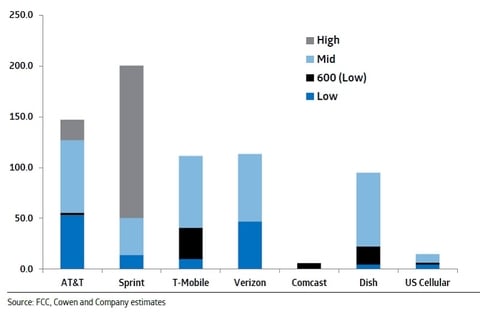
It’s worth noting that such caveats often must be applied to spectrum tallies like the above because spectrum ownership can often be a moving target, dogged by legal or regulatory complications.
Nonetheless, the Cowen analysts also offer us a look at spectrum ownership calculated through the average MHz per connection, essentially showing how much spectrum each operator can allot to each current customer.
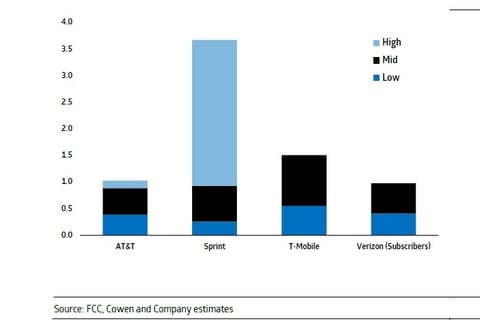
Macquarie Research also offers a similar look at the MHz-per-subscriber calculation, with relatively similar results:
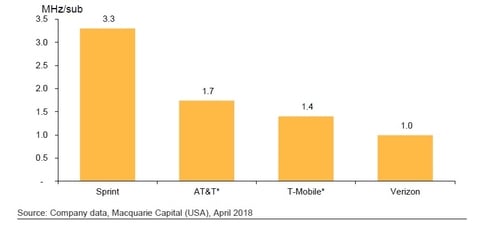
Spectrum gains
But how did we get here? The next few charts will look at which carriers have been acquiring spectrum, and how and where. But there’s one big caveat here: We’re saving our millimeter wave spectrum charts for the end of this report. If you’re interested in those specifically, including which carriers are buying millimeter wave spectrum licenses, you can scroll down to the end of this report and check those out. In the meantime, we’ll look at licenses ranging from 600 MHz to AWS to 2.5 GHz, in terms of acquisitions and ownership.
First, and perhaps most importantly, the below chart from Cowen and Company shows the prices that carriers have been paying for new spectrum licenses over recent years. These price-per-MHz-POP calculations offer a look at how spectrum prices change over time, and by the type of spectrum for sale. The dramatic increase around 2013 is likely due to the massive increase in demand for mobile data sparked by the popularity of smartphones including iPhones.
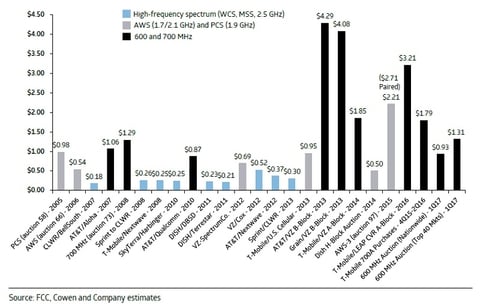
Next up are some charts from Comsearch, a spectrum-tracking operation from infrastructure provider CommScope. The company offers a look at how many MHz of spectrum have been added by the major, nationwide wireless operators in the 600 MHz - 2700 MHz bands between 2015 and 2018.
The firm found that AT&T and T-Mobile have recorded most of the gains in this spectrum—mainly thanks to T-Mobile’s acquisition of 700 MHz and 600 MHz licenses. Importantly, Comsearch also shows where these gains are happening.
AT&T:
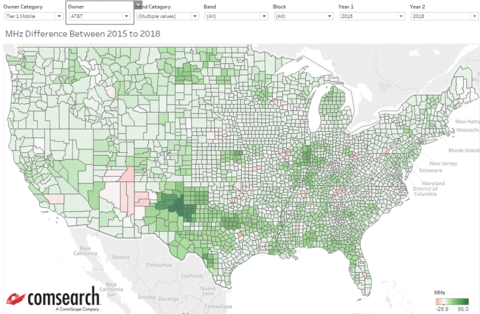
T-Mobile:
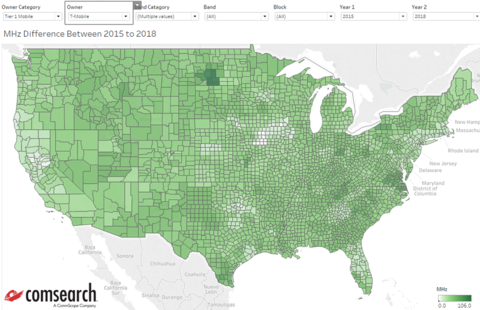
How much, who and where?
Next, we’re going to look at spectrum ownership divided up by location, amount and carrier. Again, we’re saving our millimeter wave spectrum charts for the end of this report.
The bulk of this information comes from Allnet Insights & Analytics, which carefully tracks spectrum ownership across the country and across all of the FCC’s spectrum bands.
Allnet’s first chart digs into the low-band spectrum scene, from an aggregate ownership standpoint:
And then the firm breaks into that information by looking at the 600 MHz band specifically:
And the 700 MHz band specifically:
Allnet then charts the midband spectrum scene, first from an aggregate ownership standpoint:
And then by digging into the different bands including AWS-1:
AWS-3:
SMR:
EBS/BRS:
PCS:
WCS:
The millimeter wave
If you’ve made it this far, you’re in luck. The millimeter wave spectrum bands (basically anything above 20 GHz) is where all the action is happening right now.
But first, what makes these bands different? Millimeter wave spectrum bands are named that because the wavelengths range from 10 millimeters to 1 millimeters. They’ve been available in both licensed and unlicensed formats for decades, but they’ve risen to prominence in recent years thanks to new research from the likes of NYU Wireless and others showing that such spectrum can be used for short-range, high-speed, reliable communications. Indeed, the 5G standard was initially developed to create an equipment ecosystem for these spectrum bands.
So what can they do? Verizon, for example, has said it can offer 1 Gbps internet connections in 28 GHz beyond 2,000 feet.
And that’s a big reason why there’s so much new interest in these bands. The best example of this interest is the bidding war over Straight Path’s millimeter wave spectrum licenses, which Verizon ultimately won for $3.1 billion.
And now, other carriers are pushing for the FCC to release additional millimeter wave spectrum, and in response the agency has scheduled the world’s first millimeter wave spectrum auction for November. That action will give the industry a real sense as to what the value of this spectrum is.
But until that auction, here are some charts showing the current ownership situation around the millimeter wave bands.
First up, the analysts at Wall Street research firm Oppenheimer offer a relatively cohesive look at some of the most popular millimeter wave bands and who owns them (if the FCC owns the spectrum, then it can be auctioned).
Comsearch again clocks in with a look at the gains that AT&T has made in the 24 GHz - 40 GHz bands between 2015 and 2018 (mainly thanks to its FiberTower purchase).
And Comsearch offers a similar look at the gains that Verizon has made in the 24 GHz - 40 GHz bands between 2015 and 2018 (mainly thanks to its Straight Path purchase).
Finally, Allnet shows the aggregate millimeter wave ownership across all bands:
And then the firm breaks that information down into the individual bands, including 24 GHz:
28-31 GHz:
37 GHz:
39 GHz:
47 GHz:
